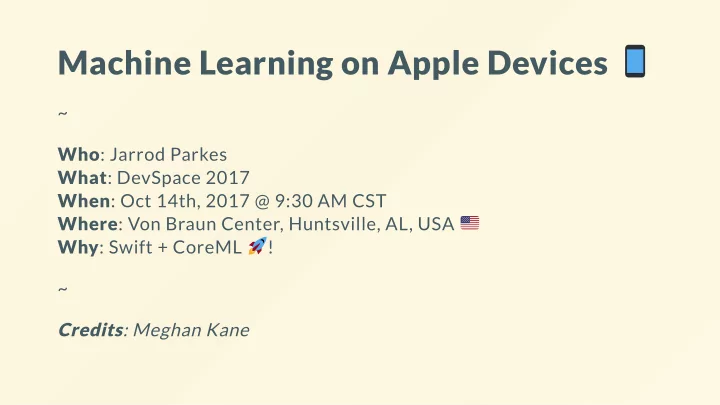

Machine Learning on Apple Devices ~ Who : Jarrod Parkes What : DevSpace 2017 When : Oct 14th, 2017 @ 9:30 AM CST Where : Von Braun Center, Huntsville, AL, USA Why : Swift + CoreML ! ~ Credits : Meghan Kane
Hey, I'm Jarrod I build iOS/Swift courses at Udacity I'm not a ML expert BUT, you don't have to be to use Core ML !
Talk Outline What is Core ML? How to use it Core ML + Vision Using custom models
How Does it Work? Core ML utilizes machine learning models Ex: neural networks "models mimicing the brain" "sophisticated statistical models" "predictors" Models are specialized for specific problems How Models are Made
Training and Core ML Core ML uses trained models (.coreml) Training happens elsewhere Tools for training: TensorFlow, Keras, Caffe, ... DevSpace session on TensorFlow
Trained Models Apple provides sample models All models are concerned with image or scene classification Pros Faster, computationally inexpensive Works offline Cons Models cannot adapt to new information Models can be large* (VGG is 553 MB, SqueezeNet is 5 MB)
The CoreML Framework New with iOS 11 Built on top of existing frameworks: Metal Performance Shaders (GPU) Accelerate (CPU) Creates easy-to-use "black box" interfaces!
Make a Predicition Links to code available at end of presentation* // create model object (for image classification) let mobileNet = MobileNet() // input is an image (as a pixel buffer) let pixelBuffer = Converter.toPixelBuffer(image: image) // simple interface to transform image into a prediction if let prediction = try? self.mobileNet.prediction(image: pixelBuffer) { return prediction.classLabel }
DEMO: First Core ML App
Improving with Vision // can we get rid of this? let pixelBuffer = Converter.toPixelBuffer(image: image) ^ Can we get rid of this? Yes! With the Vision framework Provides a wrapper for image-based Core ML models
Setup a "Vision Model" // create vision model guard let visionModel = try? VNCoreMLModel(for: mobileNet.model) else { fatalError("Unable to convert to Vision Core ML Model") } // create request "use this model, then pass results to..." let visionRequest = VNCoreMLRequest( model: visionModel, completionHandler: self.handleResults ) // create handler "processes requests" let handler = VNImageRequestHandler( cgImage: image.cgImage, orientation: image.orientation )
Perform Inference // start processing requests on a background thread DispatchQueue.global(qos: .userInitiated).async { do { try handler.perform([visionRequest]) } catch { print("Error performing classification") } }
Handle Results // handle the results! func handleResults(for request: VNRequest, error: Error?) { // switch back to main thread DispatchQueue.main.async { // ensure there are results guard let classifications = request.results, let topClassification = classifications.first else { print("nothing recognized") } // do something with results! let imageClass = topClassification.identifier } }
DEMO: Core ML + Vision
Better Vision One step further? Real-time object classification Uses Vision and AVFoundation frameworks
Capture Output func captureOutput(_ output: AVCaptureOutput, didOutput sampleBuffer: CMSampleBuffer, from connection: AVCaptureConnection) { guard let buffer = CMSampleBufferGetImageBuffer(sampleBuffer) else { return } // create handler (OLD WAY) // let handler = VNImageRequestHandler(cgImage: image.cgImage, // orientation: image.orientation) // create handler "processes requests" let handler = VNImageRequestHandler(cvPixelBuffer: buffer, orientation: .upMirrored, options: requestOptions)
Capture Output // handler created... // "use this model, then pass results to..." // // let visionRequest = VNCoreMLRequest(model: model, // completionHandler: handleResults) // // let visionRequests: [VNRequest] = [visionRequest] // start processing requests! do { try handler.perform(self.visionRequests) } catch { print(error) } }
DEMO: Real-Time Object Classification Video Link
Using a Custom Model Can you do something other than image classification? Yes, a few examples... Recommendations (Netflix, Amazon, etc.) Image style transfer Custom glasses from facial scans (Topology Eyewear) Many things can be built on top of image classification Skin cancer detector
How? coremltools A python tool for creating and testing Core ML models Can convert popular formats into Core ML models Keras Caffe Tensowflow Xgboost scikit-learn libSVM
Model Converstion from keras.models import load_model import coremltools # load keras models model = load_model('food101-model.hdf5') # create core ml model coreml_model = coremltools.converters.keras.convert( model, input_names=['image'], output_names=['confidence'], class_labels='labels.txt' ) # set metadata... coreml_model.author = 'Udacity'
Test and Save Model from PIL import Image # get image input bibimbap = Image.open('bibimbap.jpg') # perform inference coreml_model.predict({'image' : bibimbap}) # check outputs, verify top classification... # save model coreml_model.save('Food101Net.mlmodel')
DEMO: Using a Custom Model
Review Core ML, "on-device" machine intelligence! Easy-to-use interface Supports many custom models Used extensively by Apple apps, and more to come...
Questions ? Slides available @ jarrodparkes.com
Thank You ! Code Samples, presentation on jarrodparkes.com ~ Apple: Machine Learning Apple Docs: Core ML and coremltools Clarifai (new SDK for "on-device training") Udacity: ML Nanodegree Program Coursera: Machine Learning (Andrew Ng)
Recommend
More recommend